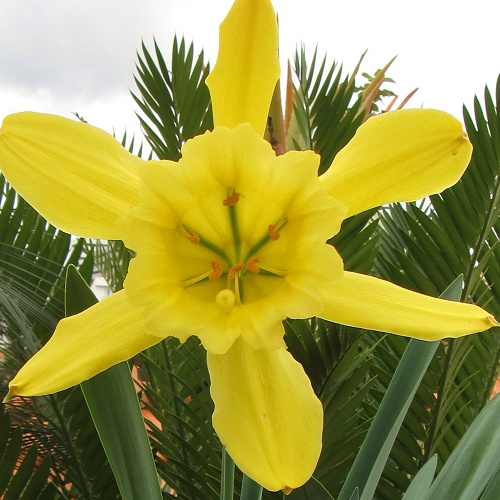Planting the bulb
Pot size -- If your bulb is about ¾ inch (2 cm) wide or less, start it in a 3-4 inch (8-10 cm) wide pot that is at least 4 inches (10 cm) tall. This will hold it the first year. Soil -- Use a very fast draining mix. A typical mix is 3 parts perlite, pumice rock, or coarse horticultural sand to 1 part coir fiber, compost, or potting soil. Screen the mix of any large chunks (skip this step for older bulbs). Plant the bulb so the top of neck is exposed, with the rest buried. Eventually it may dig itself deeper, which is fine. The bulb is usually dormant for several months. During this time, keep the soil slightly moist, so the roots stay alive. Don't let the soil dry out completely, but also don't let it get more than halfway moist or it may rot. Until it sprouts, keep it in moderate temperatures, away from high heat or cold. Once it sprouts, keep the soil evenly moist (but not constantly saturated) throughout the growing season. Growing onward... It likes mostly sunny conditions, or the equivalent amount of artificial lighting (See: "Growing indoors with LED lights"). It likes mild temperatures during the winter growing period (October to April in the northern hemisphere). During this time it can tolerate warm conditions if nights are cool (below 65°F / 18°C). It's possible that the combination of hot days with warm nights might stress it. Fortunately, the bulb is usually dormant during summer in the northern hemisphere. In hotter conditions, keep the pot shaded, perhaps by placing it inside a second pot made of clay. Temperatures above 50°F (10°C) are best during winter. It can tolerate cooler conditions, but it requires protection from frost. Fertilizing -- It enjoys ample fertilizer. Use a general-purpose fertilizer that contains micronutrients. Choose one labeled for indoor plants if your plant is inside. Feed when it sprouts, and again 2 and 4 months later (avoid feeding when it nears dormancy). An alternative is to use liquid hydroponic fertilizer, either feeding light doses weekly, or stronger doses every 2-4 weeks. Dormancy -- The leaves will die back as the bulb prepares for dormancy around April. Reduce the watering when this happens. Note that if the leaves turn yellow in the middle of the growing season, the roots might be too dry. Transplanting -- Once your bulb goes dormant, repot it into fresh soil in a tall container about 5-6 inches (13-15 cm) wide. Repot gently to avoid disturbing the roots. The following year, move it to fresh soil in a tall pot about 7-8 inch (18-20 cm) wide pot, which can hold it until flowering. When it nears maturity, baby bulbs can grow from it on long stolons. Feel free to separate the babies during dormancy once they form roots. Avoid disturbing the mother bulb's roots, which may delay flowering. If you choose to leave the babies attached to the mother bulb, they will eventually need a wider pot, since they don't like to be too cramped. Pests to watch for -- Mealybugs may attack the bulbs (look for cottony growth near the base of the plant at soil level). To control mealybugs, try using an insecticidal soap soil drench. If you have questions, feel free to contact me. Have fun growing it! - Jeff Strange Wonderful Things
|
|||||||||


